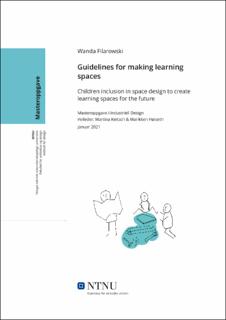| dc.contributor.advisor | Keitsch, Martina | |
| dc.contributor.advisor | Høiseth, Marikken | |
| dc.contributor.author | Filarowski, Wanda | |
| dc.date.accessioned | 2021-09-14T16:52:20Z | |
| dc.date.available | 2021-09-14T16:52:20Z | |
| dc.date.issued | 2021 | |
| dc.identifier | no.ntnu:inspera:64833797:9291248 | |
| dc.identifier.uri | https://hdl.handle.net/11250/2776827 | |
| dc.description.abstract | Flere og flere mennesker verden rundt har idag tilgang til utdanning, men lav utdanningskvalitet er fortsatt et stort problem. Derfor har FN inkludert God Utdanning som et av deres bærekraftsmål. God utdanning er en menneskerettighet. God utdanning dekker tilgang til utdannelse, inkludering, trygghet, alders-tilrettelagt utvikling for barn, tilstrekkelig med læringsmateriell og mangfold.
Mange organisasjoner har som mål å gi god utdannelse til barn. Denne masteroppgaven utforsker hva god utdannelse betyr og hvordan plasser for læring burde utformes. Hvilke funksjoner trenger plasser for læring å ha for å takle fremtidens utfordringer? En hovedtilnærming i oppgaven har vært å undersøke ulike perspektiver som påvirker utdannelse av barn. Disse perspektivene skaper et bilde på hvordan kvalitet til utdanning påvirker barns fremgang og deres evne til å lære og vokse. Oppgaven avslører også andre viktige aspekter ved utdanning.
I denne oppgaven ble det utviklet en prosess som bruker metoder og verktøy for å inkludere barn og interessenter til å lage nye plasser for læring. Formatet på denne prosessen er presentert som en prosjektplan. Å inkludere lokalsamfunnet og barnas ønsker og behov sikrer eierskap og ansvar overfor nye plasser for læring. I tillegg til en prosjektplan er det utviklet seks veiledende prinsipper for utforming av plasser for læring. De veiledende prinsippene er et nyttig verktøy for å sikre god utdannelse ved å skape bedre plasser for læring. | |
| dc.description.abstract | More and more people across the world have access to education but low quality of education continues to be a major concern. Therefore, the United Nations included Quality Education as one of their Sustainable Development Goals. Quality education is a human right. Quality education covers access to education as well as, inclusiveness, safety, age appropriate development of children, sufficient learning materials, and diversity.
Many organisations have the goal to provide quality education to children. This thesis investigates what quality education means and how learning spaces should to be designed. Which features do learning spaces need to meet future challenges? Researching different perspectives that influence education and children has been a main approach to the topic. These perspectives create a picture of how the quality of education influences childrens´ progress and their ability to learn and grow. In addition, the findings of the research reveal the important aspects of education.
In this thesis, a process was developed that uses methods and tools to include children and stakeholders into the making of new learning spaces. The format of this process is presented as a project plan. Including the wants and needs of the children and local community secures ownership and responsibility towards new learning spaces. In addition to a project plan, six guiding principles for learning space design have been developed. The guiding principles are a helpful tool to ensure higher quality education through creating better learning spaces. | |
| dc.language | eng | |
| dc.publisher | NTNU | |
| dc.title | Guidelines for making learning spaces
Children inclusion in space design to create learning spaces for the future | |
| dc.type | Master thesis | |
